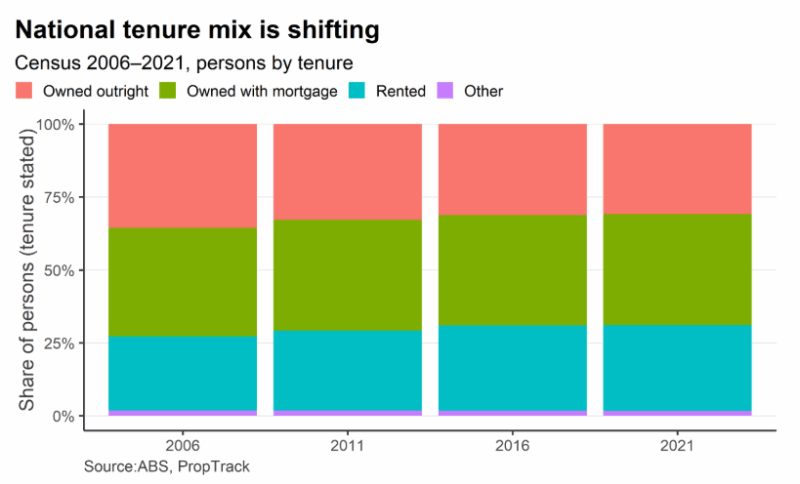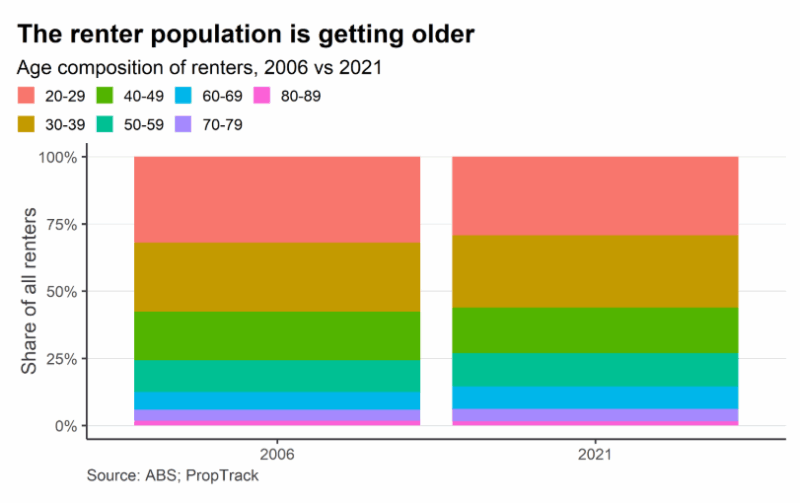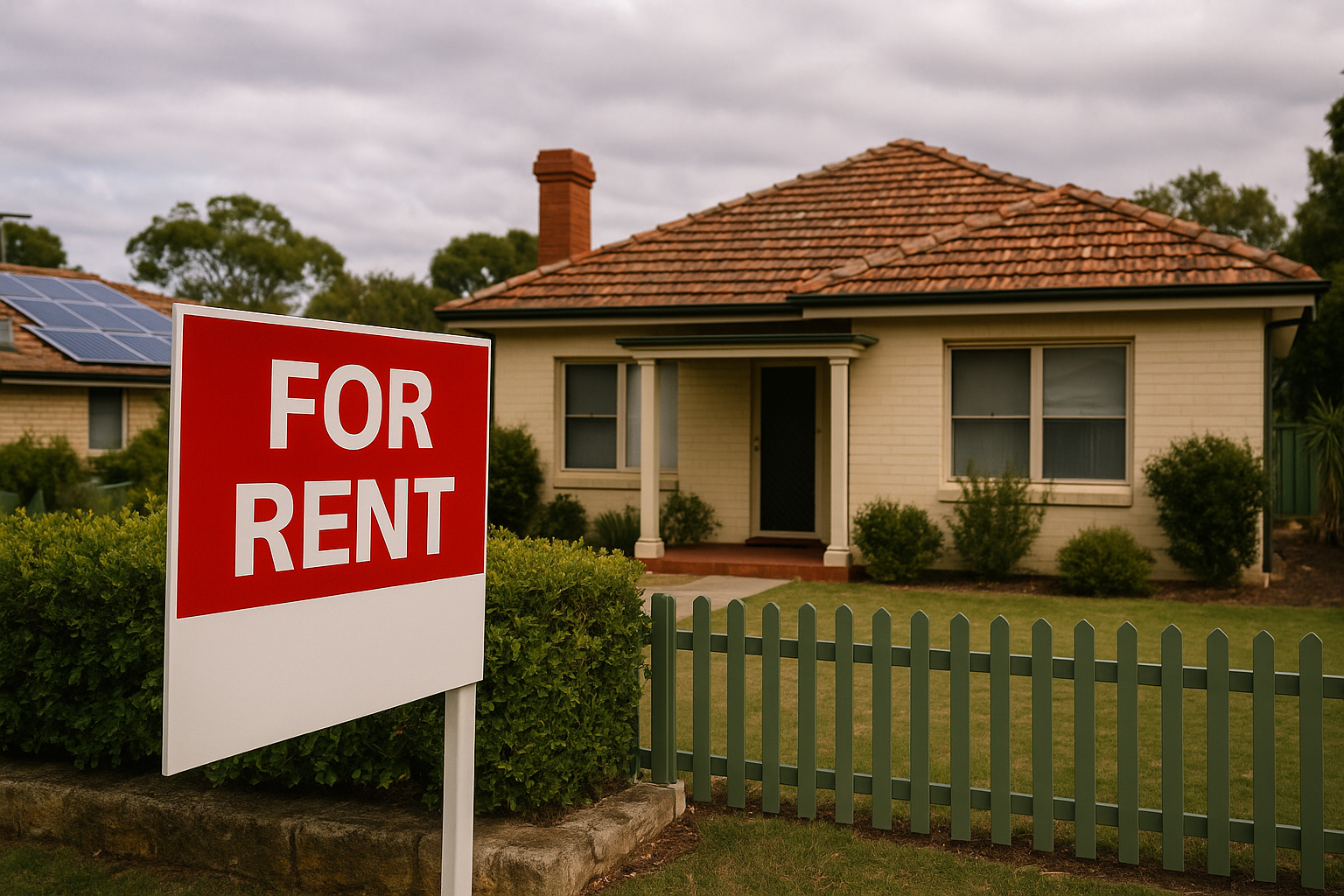
Key takeaways
Despite rising rental rates among younger generations, PropTrack modelling shows renters won’t exceed 50% of the population until well after 2100.
Ageing, where older Australians are more likely to own, keeps national ownership above majority levels.
The traditional three-tenure system is fading.
Mortgage holders + renters are now the dominant bloc, overtaking outright owners around 2024.
Outright ownership is happening later in life and becoming rarer among younger cohorts.
Millennials own far less at the same age than Gen X or Baby Boomers did.
Rising deposits, later life milestones, and larger mortgages mean people rent longer and carry debt well into older age.
Since 2006, every age group has seen an increase in renting—especially 30–39 year-olds.
More Australians are becoming long-term or even “forever” renters, fundamentally changing the rental landscape.
Inter- and intra-generational divides are widening. Access to homeownership increasingly depends on income, job security, and parental wealth.
Policy must improve both rental security and pathways to ownership to prevent a permanent housing divide.
Every so often, a headline flashes across the media warning that Australia is “becoming a nation of renters.”
It’s dramatic. It’s clickable.
And it taps into a very real anxiety among Australians, especially younger ones, who feel homeownership drifting further out of reach.
But as with most sweeping claims about the property market, the truth is more nuanced.
Yes, the housing landscape is changing.
Yes, renting is rising across all age groups.
And yes, affordability pressures are reshaping the traditional path into ownership.
But the idea that Australia is on the brink of becoming a majority-renter nation simply doesn’t stack up when you dig into the data.
As Eleanor Creagh, PropTrack's Senior Economist, puts it:
“Australia is becoming a mortgage or rent nation as we age, but on current trends, a majority renter nation is a next century prospect.”
In her article on realesatate.com.au she break down exactly what’s shifting, what’s driving it, and what it means for property markets, wealth accumulation, and policy direction over the coming decades.
From three tenures to two: a slow but significant structural shift
Historically, Australians fell into one of three clear tenure categories:
-
Owned outright
-
Owned with a mortgage
-
Renting
For decades, this three-tenure model held strong.
But PropTrack’s latest modelling shows a very different future emerging: a slow transition to a two-tier system, dominated by:
-
mortgage holders, and
-
renters

The group of outright owners is shrinking as a share of the population, not because fewer people eventually own outright, but because ownership is reached much later in life.
The core drivers here are well known to anyone observing the market:
-
High prices relative to income
-
Slower deposit accumulation
-
Tight rental markets keeping people in rentals for longer
-
Larger mortgages with longer repayment horizons
-
Life milestones occurring later (family formation, stable partnerships, career stability)
PropTrack’s data confirms what many of us have been observing for years: ownership is becoming a later-life achievement rather than a rite of early adulthood.
Younger Australians are starting the race from further back
If you want a snapshot of generational change, look no further than homeownership rates by age group:
-
Millennials (25–39) in 2021: only 55% owned a home (with or without a mortgage)
-
Gen X at the same age (2006): 62%
-
Baby Boomers at the same age (1991): almost 66%

That’s a huge shift in just a couple of generations.
PropTrack’s quasi-longitudinal modelling, which tracks ownership step-ups as each cohort ages, helps explain why:
-
Younger generations begin adulthood with lower ownership rates.
-
They experience slower transitions from renting to owning.
-
And many never catch up to where previous generations ended up.
This isn’t just about affordability, it’s about timing. People are renting longer because they’re locked into a rental cycle while trying to save for larger deposits.
Even after they buy, they hold mortgages well into later life because they buy later and borrow more.
Ageing is the key reason we won’t become a nation of renters
The PropTrack modelling clearly shows that even though younger generations rent for longer, Australia will not become a majority-renter nation this century because our population is ageing.
And older Australians are still far more likely to own their homes, many outright.
By 2050, one-third of the population will be 55 or older.
This demographic shift holds the national ownership rate above 50%, despite the renter share rising steadily among younger cohorts.

Under current trends:
-
Renter share reaches ~36% by 2050
-
~40% by 2100
-
And doesn’t cross 50% until well after 2100

Note: In other words: We’re not heading for a renter majority.
We are heading for a future where renting is normal for longer, across more life stages.
Renting is no longer just a 20's phenomenon
This is one of the clearest signals of change.
PropTrack’s data shows renting increasing across every age band, not just among the young.
Key insights include:
1. The 30–39 cohort shows the biggest shift
The renter share here has risen more than 8 percentage points since 2006.
This age group used to be firmly in family-formation and home-buying mode. Now, many are still renting.
2. Older Australians make up a larger share of renters
This is a major break from historic patterns.
It suggests a growing cohort of long-term renters who may never transition into ownership.
3. Renting spans more life stages than ever before
Renting is no longer a temporary stop; it’s often a decade-long tenure (or longer).
All of this reinforces that the real challenge isn’t renter numbers, it’s renter experience.
The mortgage-or-rent majority is already here
PropTrack points out a milestone most people missed:
-
At the 2021 Census, mortgage holders already outnumbered outright owners.
-
By around 2024, the combined mortgage + rent group overtook outright ownership as the largest bloc.
That’s a profound structural change, and it will define our housing system for decades, because:
-
People buy later
-
They borrow more
-
They take longer to pay down debt
-
And some never buy
Baby Boomers were roughly three times more likely to own outright in their 20s and 30s than Millennials. That gap won’t close without a major shift in affordability or policy.
Could we ever become a majority-renter nation?
PropTrack tested tougher assumptions:
-
Higher migration
-
Faster renter growth
-
Weaker transitions into homeownership
-
Slower step-ups across age cohorts
And even under these stress-tested scenarios, renters did not reach the majority this century.
They conclude that for Australia to shift into a renter-majority society, we’d need:
-
A structural break in the ownership pipeline
-
A generation permanently shut out
-
A collapse in real income growth
-
Policy that increasingly favours institutional landlords over owner-occupiers
-
Or a radical shift in cultural preferences
None of these appear likely at scale.
While the renter majority narrative is inaccurate, there is a genuine challenge unfolding, one that PropTrack’s data highlights clearly:
Inter-generational inequality
Creagh explains that younger Australians:
-
buy later
-
borrow more
-
repay for longer
-
rely more heavily on parental assistance as the “bank of mum and dad” is no longer a bonus; it’s often a necessity.
Intra-generational inequality
Even within the same age group, outcomes diverge sharply based on:
-
income
-
job security
-
savings capacity
-
and access to family wealth
We’re moving toward a housing system that risks locking out lower-income Australians entirely unless supply, planning, and policy improve.
Policy must evolve: renting needs stability, ownership needs pathways
If renting is now a long-term tenure for millions, policy must adapt according to Creagh.
She believes we need:
-
more secure leases
-
higher minimum rental standards
-
fairer rental processes
-
incentives that support long-term rental supply
-
and a regulatory environment that attracts institutional investment without driving out private landlords
For buyers, we need:
-
a more efficient planning system
-
faster approvals
-
greater urban infill
-
more medium-density supply
-
a stable tax and regulatory environment
-
and policies that reduce, not inflate, entry barriers
None of this is radical.
All of it is achievable.
But without it, the generational wealth gap will continue to widen.
Final thoughts
So, while Australia is NOT on track to become a nation of renters within this century, we are becoming a nation where:
-
renting lasts longer
-
mortgages last longer
-
outright ownership happens later
-
and inequality in access to ownership is growing
The centre of gravity has shifted to a mortgage-or-rent nation.
That’s the real story, and it’s one that will shape property markets, wealth building, and policy debates for decades to come.
For investors and homeowners, these trends reinforce the importance of long-term strategy and understanding demographic shifts.
For policymakers, they highlight the need to improve both sides of the housing equation:
-
better rental conditions,
-
better pathways to ownership,
-
and more supply where people actually want to live.
If we can achieve that balance, Australians will continue to make the leap from renting to owning, just later and more slowly than their parents did.














